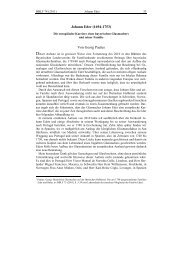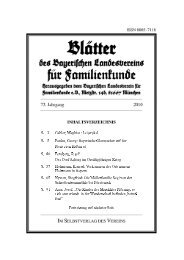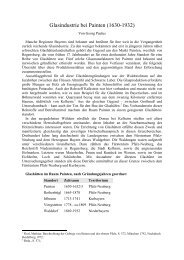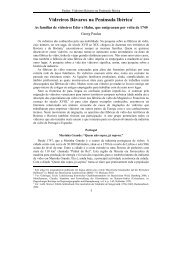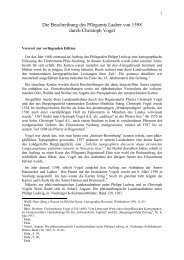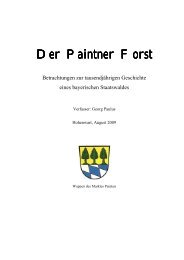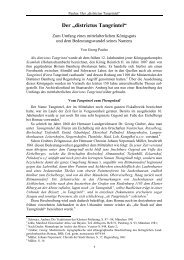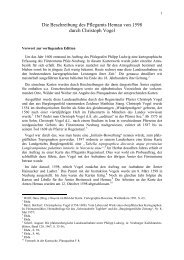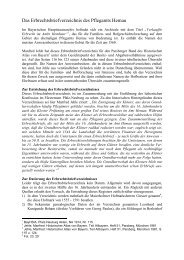Johann Eder - Georg Paulus
Johann Eder - Georg Paulus
Johann Eder - Georg Paulus
You also want an ePaper? Increase the reach of your titles
YUMPU automatically turns print PDFs into web optimized ePapers that Google loves.
Transfer of Technology<br />
In the early 18th century, the production of baroque style glass with engraved motifs spread in<br />
Bohemia and Germany. Its technical base was the so called crystal or chalk glass<br />
(“Kristallglas” or “Kreideglas”), which had been developed in Bohemia, towards the end of<br />
the 17 th century. 86 This was the decisive technological step forward, which finally made the<br />
glass from Venice, until then considered as unequalled, lose its importance, and the baroque<br />
style “Kristallglas” from the Bohemian and German glassworks to dominate the market. The<br />
founders and tenants of the crystal glassworks in other European countries, who wanted to<br />
make use of that new technology, relied on the knowledge and skills of Bohemian and<br />
German glassmakers. <strong>Johann</strong> <strong>Eder</strong> and his sons mastered the new technique of making crystal<br />
glass. <strong>Eder</strong>’s career is also an example how individual specialists participated in the transfer<br />
of technology and how it was brought forward by the communication networks of artisans and<br />
by their mobility.<br />
As we have learned from the description of Antonio Ponz 87 and the comprehensive<br />
publication of Paloma Pastor on the history of the glass factory of San Ildefonso 88 , the <strong>Eder</strong>s<br />
were hollow glass makers. Even the flat glass which they made was produced by blowing. For<br />
that purpose they blew hollow cylinders, which were then cut open and processed to glass<br />
plates. The production of flat glass by casting was practised by the <strong>Eder</strong>s, at a later stage, in<br />
Spain, where Joseph <strong>Eder</strong> (1723-1782) ran the factory for flat glass (Fábrica de planos) of San<br />
Ildefonso.<br />
<strong>Johann</strong> <strong>Eder</strong>s other son, Lorenz, who had – like Joseph – accompanied his father on his<br />
journeys through Europe, had specialised in the engraving of glass and reached high skills in<br />
it. Glass objects accredited to him, can still be found in renowned museums, e.g. the National<br />
Archaeological Museum (Museo Arqueologico Nacional) in Madrid, and in Glasgow. 89<br />
Conclusion<br />
Some chapters of the life of <strong>Johann</strong> <strong>Eder</strong> (1694-1753) still remain unknown (see Chronological<br />
Table). For instance, we do not know when and where he got married, nor where he<br />
lived during the period between 1723 until his escape from Bergreichenstein, in 1738, 90 nor<br />
where his sons Lorenz and <strong>Johann</strong> were born. Anyway, the last 16 years of his life, certainly<br />
the most important chapter, could now be described. When <strong>Johann</strong> <strong>Eder</strong> left Germany at the<br />
age of 45 to go to Portugal, he already disposed of a wide experience as a glassmaker and<br />
tenant of a glassworks. After that, he spent ten years in Sweden and Norway, where he took<br />
part in the establishment of the crystal glassworks at Kosta und Nøstetangen, the first ones of<br />
their kind in the said two countries. The height of his career was certainly when he managed<br />
to be employed by the King of Spain and was put in charge of the construction and direction<br />
of the „Fábrica de Entrefinos“ at San Ildefonso, in 1750. This way, he had also provided for<br />
the future of his sons Joseph und Lorenz, who achieved fame and glory within the<br />
glassmakers’ guild of Spain. Before that, he had managed to place his nephews Adam and<br />
Balthasar with the glass factory in the Portuguese Coina. His son <strong>Johann</strong> worked as a smelter<br />
at Sandö in Sweden.<br />
86 Cf. Hirsch, Ernst: Die Erfindung des böhmischen Kristallglases. Ein Beitrag zur Geschichte der Glasindustrie<br />
auf der Buquoy'schen Herrschaft Gratzen in Südböhmen, in: Mitteilungen des Vereins für Geschichte der<br />
Deutschen in Böhmen, 1936.<br />
87 Ponz, Antonio: Viage de España: en que se da noticia de las cosas mas apreciables, y dignas de saberse, que<br />
hay en ella; Madrid 1781, p.128-129.<br />
88 Pastor Rey de Viñas: Historia de la Real Fábrica de Crystales de San Ildefonso durante la Epoca de la<br />
Ilustración, San Ildefonso 1994.<br />
89 Cf. http://collections.glasgowmuseums.com/starobject.html?oid=81993 (download: 23 Jan. 2011).<br />
90 Cf. <strong>Paulus</strong>, <strong>Georg</strong>: Bayerische Glasmacher, 2010.<br />
12



